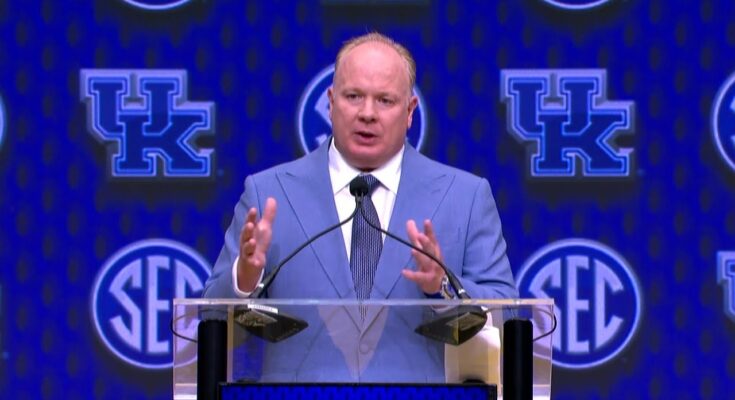Can Mark Stoops Spark a Kentucky Revolution? The Blueprint Might Be Hiding in Missouri
Kentucky football stands at a crossroads, a place where the weight of potential collides with the burden of expectation. Under Mark Stoops, the Wildcats have made undeniable progress, transforming from an SEC afterthought into a program that demands respect on Saturdays. Bowl appearances have become routine, recruiting battles are more competitive, and the culture inside the program is stronger than ever. Yet, despite all these achievements, there’s an unmistakable sense that Kentucky is flirting with the ceiling of its capabilities. The question lingering in the air is simple: can Stoops push this team from being good to being truly great? And perhaps the answer lies just a few states away, in a program that knows a thing or two about defying expectations—Missouri.
To understand why Missouri serves as such an intriguing case study for Kentucky, you have to revisit the context of their journey in the Southeastern Conference. When Mizzou made the leap from the Big 12 to the SEC in 2012, few believed the Tigers could ever compete in a league dominated by blue bloods like Alabama, Georgia, LSU, and Florida. The narrative was that Missouri would struggle to survive, let alone thrive, in college football’s most brutal gauntlet. Yet within just two seasons, Gary Pinkel had the Tigers playing for an SEC Championship, not once but twice, in 2013 and 2014. They didn’t win the ultimate prize, but those runs shattered preconceived notions and proved that with the right formula, a so-called “outsider” could crash the party.
That formula—adaptability, resourcefulness, and cultural buy-in—should resonate deeply with Stoops and Kentucky fans. Missouri didn’t out-recruit Georgia or Alabama during its surge, nor did it suddenly transform into a hotbed of five-star talent. Instead, the Tigers thrived by understanding who they were and leveraging their strengths. They leaned on player development, creative scheming, and an unrelenting sense of belief. They built rosters that may not have wowed on signing day but fit their system and bought into the vision. In short, they maximized what they had and squeezed every ounce of potential out of it.
Mark Stoops has already laid the foundation for Kentucky to follow a similar path. Since arriving in Lexington, he has turned a program synonymous with mediocrity into a consistent winner. The Wildcats are physical, disciplined, and fearless in the trenches—a philosophy that has allowed them to compete against more talented teams. Stoops has elevated recruiting to levels Kentucky hasn’t seen in decades, even if the program still lags behind the SEC’s elite. But if history is any indication, talent disparity doesn’t have to be a death sentence. Missouri proved that ten years ago, and their success serves as both a reminder and a roadmap for what’s possible.
So, what would it take for Kentucky to replicate that magic? The first step is embracing an identity. Missouri thrived because it knew exactly who it was and never tried to be something else. They didn’t chase Georgia’s star power or Alabama’s NFL factory model—they built their own blueprint and stuck to it. For Kentucky, that means doubling down on the traits that have defined their rise under Stoops: toughness, development, and execution. This program’s calling card has been its ability to win games in the trenches, control the clock, and impose its will physically. That identity isn’t broken—it just needs refinement and an injection of creativity to keep pace with an evolving SEC landscape.
The second piece of the puzzle is quarterback play, the ultimate X-factor in college football. Missouri’s best seasons in the SEC came when they had reliable, confident quarterbacks like James Franklin and Maty Mauk who complemented their offensive system. For Kentucky, the revolving door under center has too often been a limiting factor. Stability at the quarterback position is more than a luxury; it’s a necessity if Kentucky wants to rise above the pack. Stoops has made strides in modernizing his offense and attracting better quarterback talent, but finding the right guy—and building the scheme around his strengths—could be the difference between another solid eight-win season and a legitimate run at Atlanta.
And then there’s recruiting philosophy. Missouri’s success was rooted in finding diamonds in the rough and developing them into stars. They knew they couldn’t simply waltz into five-star territory, so they targeted players who fit their system and culture. Kentucky, under Stoops, has adopted a similar mentality but has also cracked the door open to higher-profile recruits. The challenge now is balancing those two worlds: continue to dominate in player development while capitalizing on the growing respect Kentucky has earned on the trail. If the Wildcats can consistently blend top-25 recruiting classes with their trademark developmental edge, they’ll have the roster to compete for more than mid-tier bowl games.
Perhaps the most compelling aspect of this comparison lies in the psychology of expectation. Missouri’s breakthrough was as much about mindset as it was about scheme. The Tigers didn’t just play like they belonged—they believed it. That confidence permeated everything they did, and it’s something Kentucky must fully embrace. Stoops has instilled a culture of toughness and resilience, but now comes the next evolution: a culture of expectation. No more celebrating six or seven wins as the pinnacle. No more moral victories against ranked opponents. If Kentucky wants to take the leap, the standard has to change internally before it can manifest on the field.
There’s no denying the challenge. The SEC is even more formidable now than it was a decade ago. Georgia has ascended to dynasty status, Alabama remains a juggernaut under Nick Saban’s shadow (or whoever succeeds him), and programs like Tennessee, Ole Miss, and LSU are all pushing hard for relevance. Kentucky’s margin for error is razor-thin. But that was true for Missouri, too. They didn’t wait for the perfect storm—they created it. They seized the moments when the traditional powers stumbled, and they capitalized on their opportunities. If Kentucky can do the same, if they can pair their physical style with offensive explosiveness and elite-level development, there’s no reason why the Wildcats can’t write their own underdog story.
The truth is, Stoops has already brought Kentucky further than most ever imagined. He’s the longest-tenured coach in the SEC for a reason, and his loyalty to the program speaks volumes. But every coach faces a defining moment—a point where good isn’t good enough anymore. For Stoops, that moment is here. The infrastructure is in place. The resources are better than ever. The fan base is hungry for more. The only question left is whether Kentucky is ready to stop dreaming about being Missouri circa 2013 and start becoming that team in real time.
In the end, inspiration is just a spark. What Kentucky does with it will determine whether this program stays in the middle of the SEC pack or ascends into a tier that once felt unreachable. Missouri showed the college football world that in this league, surprises are possible. Now it’s up to Stoops and the Wildcats to decide if they want to be the next great surprise—or just another team looking up at the giants.



